“With great risk comes great reward,” is one of Thomas Jefferson’s great quotes. That’s a good way to sum up the Alaska polar bear adventure I just ran. We took a gamble on a very out-of-the-way place and the weather, and came up with a big win. Here’s how that came to be.
I’ve been leading photography trips for Pack Paddle Ski for about fifteen years. These trips tend to be a bit exotic and usually overseas, and I’m always on the lookout for new ones. Which is why I was talking with Rick (the owner) about putting together a polar bear trip a couple of years ago. We considered Churchill (Manitoba), but that’s what everyone else does, and is pretty one-dimensional (just polar bears). Instead, Rick suggested we try something different, but that would come with the risk of bad weather and travel problems.
Rick’s been leading backpack and raft trips into the Brooks Range for decades. That’s in far north Alaska, a difficult place to get to, and requires bush planes. Which is how he came to learn about Barter Island. It’s home to Kaktovik, a small Inupiat community just off the mainland in the Beaufort Sea. In time he discovered they still hunt whales, which is allowed because of their traditions and because those whales provide meat to help the isolated community survive. The people take three whales each fall, and after dividing the meat among the community, haul the bones and leftovers out to a spit of sand a ways from the village. At the same time, polar bears in the area have been struggling to survive in a changing climate, which has reduced the ice they depend on to hunt seals. Polar bears have an incredible sense of smell, and it didn’t take them long to discover what the locals call the “bone pile,” near the ocean. And that means Barter Island is a magnet for polar bears in the fall.
Rick realized that combination – a traditional Iunpiat community, whale hunts and dozens (literally) of polar bears would present great photo opportunities. Oh, and we might get Northern Lights too. However, the weather at that time of year (early September) is unpredictable. Temperatures in the 30s to 50s are the norm, as is rain and fog. Also, the small planes that fly from Fairbanks to and from Barter Island are rarely on time and regularly delayed a day or more. In other words, this could be a logistical nightmare. Rick’s solution to this was to build a trip that had us spending three nights on the island, then back to Fairbanks and off to a resort east of there for another three nights. If we were delayed getting to and/or from the island, we’d have some time in the schedule to work with. Oh, and we had to book everything a year in advance.
The first challenge for me was to make sure that anyone who wanted to do this trip understood the challenges and level of difficulty it might entail. You needed to be able to rough it and roll with the punches. Small planes, basic accommodations and a small boat in possibly rough water. Fortunately, after leading trips for many years, I quickly had a small group (six plus me) that could take whatever this trip threw at us.
And you know what? We were incredibly lucky. While our flights out and back were both delayed, we made it on the scheduled days. The locals had already gotten two of their whales before we arrived, and they got the third the day after, so we were able to witness that. And the weather was unusual, in a good way. Sunny and relatively warm, with calm waters. When we commented on how beautiful it was, our guide said, “Yeah, we get a day like this every ten years or so.”
Not only was the trip to the island a great success, but the second part of the trip, to Chena Hot Springs, was incredible as well. Fall foliage, sunny and warm, and some amazing Northern Lights. Oh, and a moose or two.
Enough talk. Let me show you some of the photos and what’s happening with each one. One technical note before getting to the photos: since we’d be doing a lot of our photography from a boat, with long lenses, I reminded everyone to stay at high shutter speeds (preferably above 1/1000). For the Nikon shooters in the group, I suggested they use the Auto ISO Sensitivity option, which let them set a minimum shutter speed and maximum ISO. That’s why you’ll see those photos of mine from the boat at either 1/1250 (when the boat was fairly steady) or 1/1600 (when there was more movement), and some ISO numbers that seem a bit strange.
And if you’d like to join me on a different adventure, but a more predictable one than this, I’m headed to Peru in April of 2018. It’s a great trip, filled with culture, history and great people photography. Plus, of course, Machu Picchu! There are still a few spots left, so don’t wait too long to book. You can find photos from the last trip here, as well as a write-up about it here. And the complete itinerary, plus registration information, is on Pack Paddle Ski’s website here.
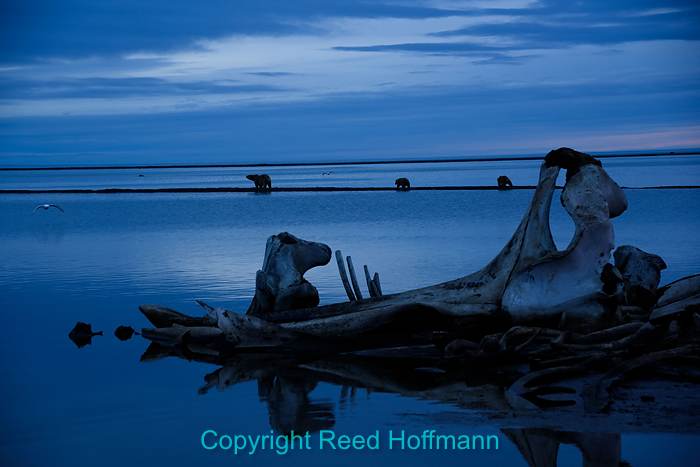
Our first full day in Kaktovik we started early with a visit to the bone pile by truck. While we had several opportunities to photograph the polar bears nearer us, with the low, moody light, I preferred this wide shot iwth a few in the distance. Nikon D750, Aperture Priority, ISO 320, 1/60 at f/5.6, -1.7 EV, Nikkor 24-120mm f/4G at 98mm. Photo copyright Reed Hoffmann.
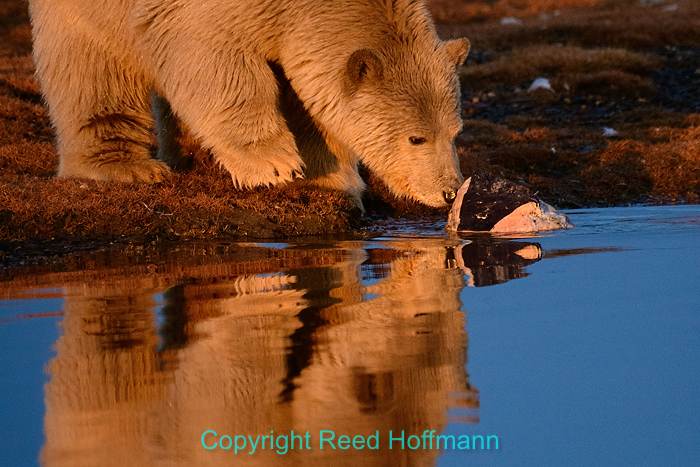
We had two beautiful days on the island, which is apparently unusual. This was the second morning there, with gorgeous early-morning light on a polar bear cub checking out some whale meat. Nikon D7500, Aperture Priority, ISO 3600, 1/1600 at f/5.6, -0.3 EV, Nikkor 200-500mm f/5.6 lens at 500mm. Photo copyright Reed Hoffmann.
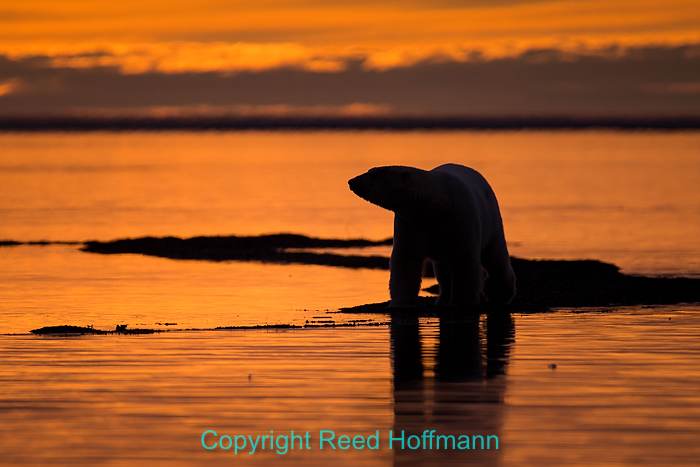
We were also blessed with a brilliant sunset on two of the evenings. The challenge was in getting the boat in a position where we could silhouette the bears against the colorful reflection, but I worked with our guide to make that happen. Nikon D7500, Aperture Priority, ISO 400, 1/1250 at f/5.6, 0.0 EV, Nikkor 200-500mm f/5.6 lens at 500m,. Photo copyright Reed Hoffmann.
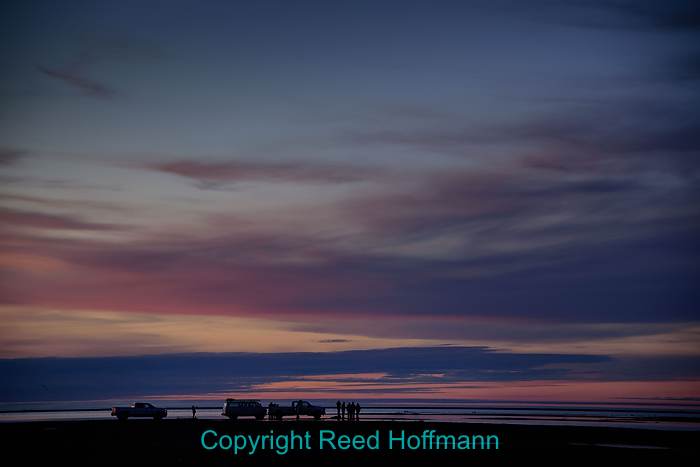
Heading back to the island after a sunset shoot, we could see some other groups, out in trucks, parked far enough away from the bears to get out and watch. For us, that would be too far for good pictures. Nikon D750, Aperture Priority, ISO 640, 1/500 at f/5 , -0.3 EV, Nikkor 24-120mm lens at 120mm. Photo copyright Reed Hoffmann.
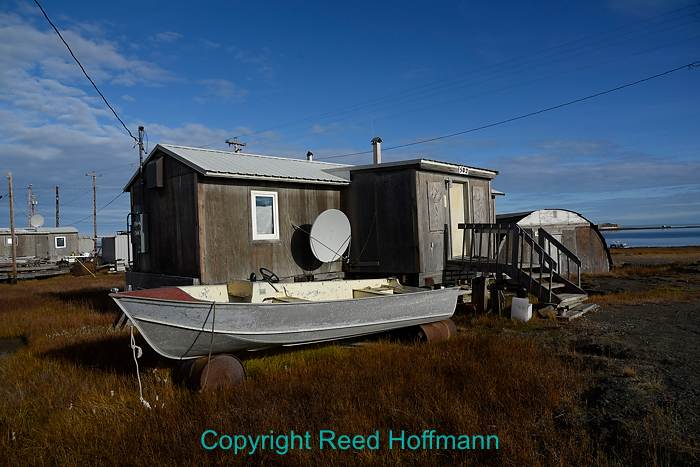
The village of Kaktovik itself is a small native community of Inupiat who live a mostly substance lifestyle. The food they don’t hunt or catch comes in each day on a scheduled flight. Larger things, like vehicles, building materials and fuel, are delivered by barge during the couple of months the island is ice free. Nikon D750, Aperture Priority, ISO 200, 1/400 at f/11, -0.3 EV, Nikkor 24-120mm lens at 24mm. Photo copyright Reed Hoffmann.
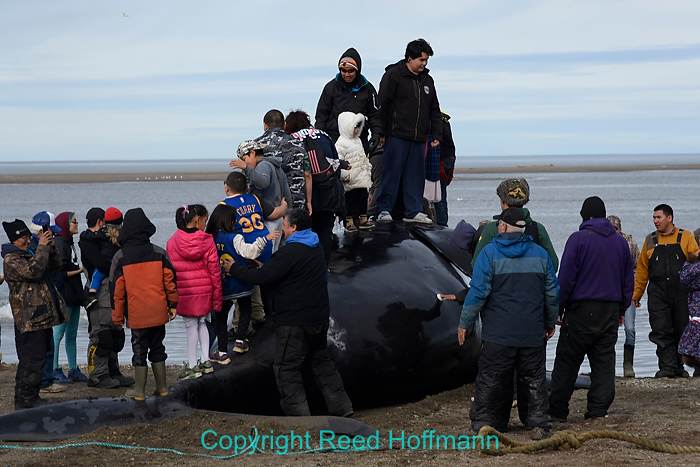
We were incredibly lucky on many counts, one being that the villagers caught their third and final bowhead whale while we were there (a quota based on the size of the community). As part of the ceremony of bringing it in, the children posed for photos standing on top of it. Nikon D750, Aperture Priority, ISO 200, 1/400 at f/7.1, 0.0 EV, Nikkor 24-120mm lens at 120mm. Photo copyright Reed Hoffmann.
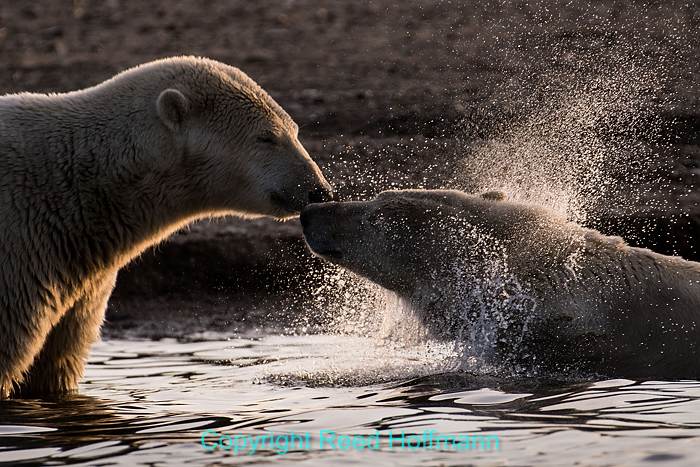
While polar bears aren’t usually considered social, we saw a lot of friendly interactions. Some of those were obviously mothers and cubs, but others weren’t. There were very few times where teeth were bared in anger. Nikon D7500, Aperture Priority, ISO 1400, 1/1600 at f/5.6, -0.3 EV, Nikkor 200-500mm f/5.6 lens at 500mm. Photo copyright Reed Hoffmann.

Of course, with cubs and food, not all interactions are friendly. This mother had a piece of whale that she and her two cubs were sharing. Another bear kept coming near to try for the meat, and at one point they challenged each other. Eventually the mother bear and her cubs left, leaving the remainder for others. Nikon D7500, Aperture Priority, ISO 2800, 1/1600 at f/5.6, -0.3 EV, Nikkor 200-500mm f/5.6 lens at 500mm. Photo copyright Reed Hoffmann.
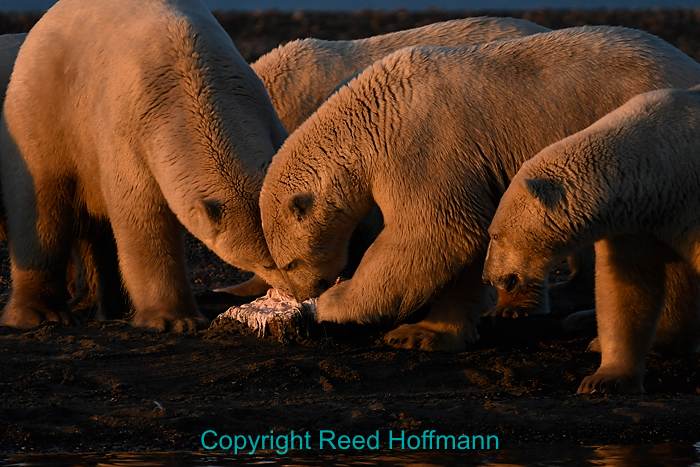
At that point, six bears gathered to share the one piece of meat. This was near the end of one of our evening shoots, again from the boat. The boar was the best way to view and photograph the bears. Nikon D7500, Aperture Priority, ISO 1600, 1/1600 at f/5.6, -1.0 EV, Nikkor 200-500mm f/5.6 lens at 500mm. Photo copyright Reed Hoffmann.
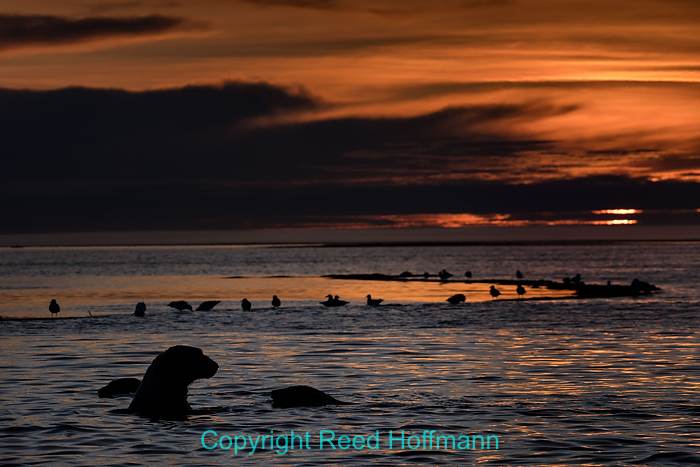
We took one last ride by the bone pile while headed back to the island on our final night. This photo is a good example of how we shot not just tight photos of the bears, but also went with wider shots to get more of a feel for where they were and what else was going on. Nikon D7500, Aperture Priority, ISO 400, 1/1600 at f/7.1, -1.0 EV, Nikkor 200-500mm f/5.6 lens at 200mm. Photo copyright Reed Hoffmann.
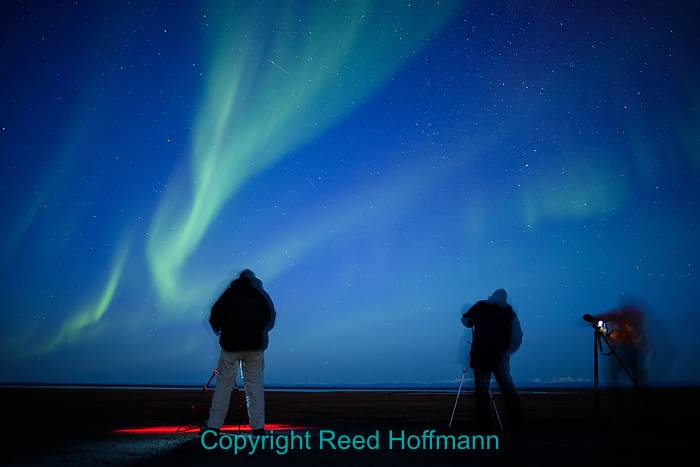
Later that night, our guide came back to the house we were staying in to let us know the northern lights were out, and offered to take us out of town (where it was darker) to photograph them. Five of us joined him for an hour. Nikon D750, Manual exposure, ISO 2000, 8-seconds at f/1.8, Nikkor AF 20mm f/1.8 lens. Photo copyright Reed Hoffmann.
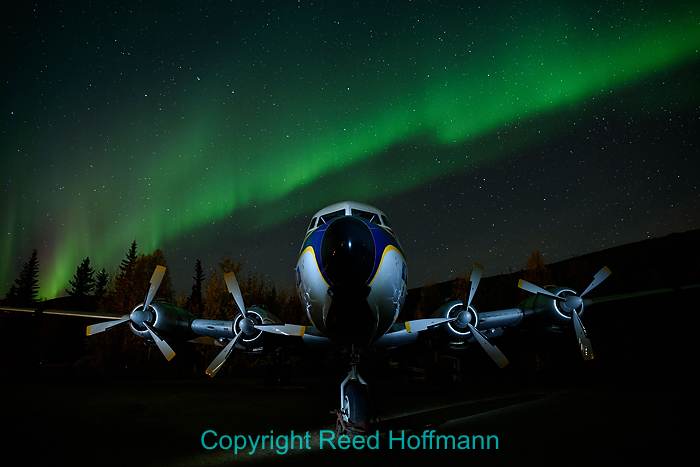
Our first night at Chena Hot Springs, we were blessed with several hours of very good northern light activity. I’d brought along my small light-painting flashlight, and taught an impromptu class on how to do that. Luckily, the resort had an old DC6 on the airstrip, which made a great foreground for the photo. Nikon D750, Manual exposure, ISO 1000, 20-seconds at f/2.5, Nikkor AF 20mm f/1.8 lens, . Photo copyright Reed Hoffmann.
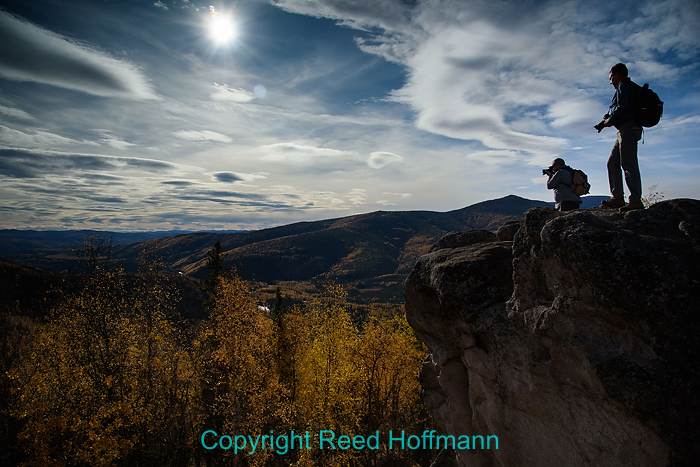
We had gorgeous weather for the final days at Chena Hot Springs, and since it was fall foliage season, some of us spent one afternoon taking a hike to Angle Rocks, nearby. I used a three-stop soft graduated neutral density filter to balance out the bright sky with the darker foreground and two of our group. Nikon D750, Aperture Priority, ISO 200, 1/1600 at f/6.3, -0.7 EV, Nikkor 24-120mm lens at 24mm. Photo copyright Reed Hoffmann.
(If you like this, please share it with your friends, and let them know about the links about photography I post on my business Facebook page. I’m also on Instagram and Twitter, @reedhoffmann)

